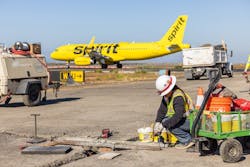Oakland International Airport (OAK) embarked on a transformative project aimed at rehabilitating Taxiway W, a crucial component of its infrastructure facilitating aircraft movements and operations.
The rehabilitation project was a collaborative effort between AECOM, DeSilva Gates Construction, LLC and OAK, aimed to address safety concerns, accommodate future growth, and ensure uninterrupted operations during construction. In addition, Royal Electric provided LED airfield lights – 254 edge lights and 104 centerline lights.
OAK Airport Operations Manager Joan Zatopek said the airport identified Taxiway W as the next rehabilitation project during a reassessment analysis of the airport’s runways and taxiways which Zatopek said is done every three years as best practice.
“Every 10 to 15 years, there is the need to rehabilitate pavements such as these taxiways and it's essential for grant assurances and for safety to keep all our pavement in good operating condition. So, we go through a process every three years of updating our pavement management system, which identifies and prioritizes the condition of the pavement and prioritizes and ranks where which projects should be programmed for the upcoming years,” Zatopek said. “So, Taxiway Whiskey was identified as the next most important and critical piece of pavement on the airport airfield to rehabilitate.”
Taxiway W is the primary departure route for nearly all operations at OAK’s primary runway. Taxiway W is utilized by general aviation, commercial traffic, cargo, military, and even SF Fleet Week air show operations.
Zatopek underscored the significance of Taxiway W, stating, "Taxiway W serves as the lifeline of our airport, facilitating the movement of aircraft and enabling efficient departures. Its rehabilitation was essential to maintaining our high standards of safety and operational efficiency."
AECOM Aviation Project Manager Duke Young shed light on the project's inception, noting, "Our involvement commenced at the project's nascent stage, aligning with the identification of Taxiway W's rehabilitation needs. We collaborated closely with the airport to formulate a comprehensive plan tailored to its operational requirements."
Collaboration emerged as a cornerstone of the project's success, with Zatopek emphasizing, "Engaging stakeholders from different departments including airport operations, air traffic control, and airline and cargo representatives, was pivotal. Their insights and feedback informed our decision-making process and ensured alignment with operational imperatives."
Zatopek said the airport has a great relationship with the FAA Air Traffic Control Tower, and their input throughout the project helped guide decisions in the design process.
“The ongoing coordination that our airside operations folks have with the tower, where we can converse with them, we can work and collaborate with them to make sure that these design ideas, work from the tower's perspective because they're the ones that are informing and directing the pilots where to land, where to how to cross, all these things when you've got construction very close to an active runway,” she said.
Young elaborated on the multifaceted challenges encountered during the project, stating, "Minimizing disruptions to airport operations posed a significant challenge, particularly given Taxiway W's central role in aircraft movements. We devised innovative solutions, such as implementing temporary bypass routes and activating alternate taxiways, to mitigate disruptions while maximizing work efficiency."
Strategic planning played a pivotal role in navigating the project's complexities, as Zatopek explained, "We adopted a forward-thinking approach, considering not only the immediate rehabilitation needs but also anticipating future changes in aircraft technology and operational dynamics. This holistic perspective guided our decision-making process and ensured the project's long-term viability."
OAK implemented two unique solutions during the project. The first was the utilization of jet blast deflectors to safely bring construction crews and equipment in closer proximity to aircraft, creating efficiencies in construction and minimizing airfield operations impacts. Secondly, OAK activated a temporary bypass taxiway around the construction site, allowing the airport to maintain aircraft and airline access to primary Runway 12-30 throughout construction.
Due to the overall length of 11,000 linear feet, Taxiway W was broken into phases. Phase 1 of the project rehabilitated approximately 1,900 feet of Taxiway W. The first phase, completed in late 2023, marked a significant milestone in the rehabilitation efforts.
“The successful completion of Phase 1 underscored the effectiveness of our collaborative approach and strategic planning,” Young said. “It laid a solid foundation for subsequent phases, reinforcing our commitment to delivering sustainable infrastructure solutions."
Looking ahead, Phase 2 of the project has been bid and construction is planned to begin in the next month, with both Zatopek and Young expressing confidence in its successful execution. Zatopek stated, "As we advance to the next phase of the project, we remain steadfast in our commitment to safety, efficiency, and stakeholder engagement. Collaboration will continue to be paramount as we navigate the project's complexities and deliver transformative outcomes for the airport and its stakeholders."
Phase 2 is poised to rehabilitate approximately 5,000 feet of Taxiway W.
The total project cost for Phase 1 was $28.7 million, with $19.2 million sourced from FAA grant funding via the Airport Improvement Program.

